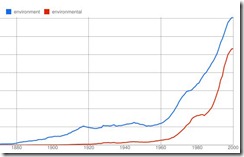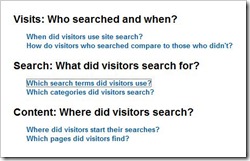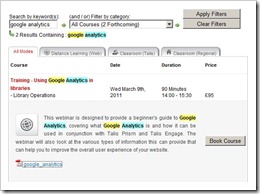Google Tools
A few days ago I mentioned a webinar on Google Analytics. Goggle Analytics (or “GA” for short) is a powerful and free tool for tracking website traffic.
It is widely used with the web-based Talis products such as Prism 3 and Engage. It offers all sorts of unexpected detail such as the browser used and connections from smart phones.
Google has a number of other tools which can be useful in a library context
Books NGram Viewer
This is not directly management information although it might be a good source of quirky facts for illustrating annual reports! You may also need to exercise some discretion on who you tell about this. To anyone with an interest in social history it is enormously compelling and it is easy to waste hours playing with it: but for some Subject Librarians it could be very helpful.
 Google Books Ngram viewer allows you to plot the frequency of occurrence of a word in literature through time. You can pick your date range, the corpus of books (e.g. American, British) and the words that you want to plot. Here for example is a plot showing the meteoric rise of the words “environment” and “environmental” in British English since 1960.
Google Books Ngram viewer allows you to plot the frequency of occurrence of a word in literature through time. You can pick your date range, the corpus of books (e.g. American, British) and the words that you want to plot. Here for example is a plot showing the meteoric rise of the words “environment” and “environmental” in British English since 1960.
It works in many languages too. Here is a search of simplified Chinese literature on the word 飞机 (“aircraft”) since 1940.
Public Data Explorer
This has two parts. Firstly a number of data sets are available for browsing which might be useful in benchmarking. Here for example is broadband penetration for selected countries (note time slider along the bottom), and here is the same data as a graph through time. This might for example be helpful in interpreting usage stats for people’s network PC. A list of some of the data sets available is here.
The second part is uploading your own data. This is not wholly straightforward (it involves writing some XML) but it is possible to load your own data sets: http://www.google.com/publicdata/admin (you need to have a Google account and be logged in to see this)
Google Moderator
Possible applications in canvassing user feedback. See http://www.google.com/moderator/#0
Google Docs
This allows you to store spreadsheets and other documents in the cloud and grant access to others. You can also publish them as web pages on line – see http://docs.google.com. The latter is particularly powerful: if you have data that you want to make available to a wide audience, publish as HTML and send your audience the link.





Recent Comments